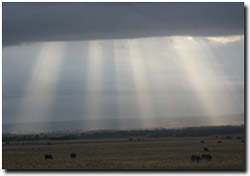Climate
|
In West Gippsland, the major influence on climate is the easterly movement of high and low pressures systems and southerly movement of low-pressure systems off the east coast of southern Australia. The region has a Mediterranean climate with maximum temperatures and minimum rainfall in summer. This is tempered in coastal areas and the east of the region by frequent coastal depressions, creating milder temperatures and a more evenly distributed annual rainfall. Droughts are often experienced from mid-October to late April. |  Sun filtering through clouds near Bald Hills (photo: Mark Imhof) |
The climate varies with elevation, topography and distance from the coast. Lowlands tend to be warmer and drier, changing to cooler, wetter highlands. The Gippsland Plains are topographically uniform and show little variation in climatic conditions compared with mountain areas.
Climate and Weather Data |
Daily and weekly rain, temperature and general weather observations (external link)
Forecast information, including provincial city and fire weather forecasts (external link)
West Gippsland climate averages (external link)
The Bureau of Meteorology website provides a regular radar update covering a 256 km radius from Melbourne (external link)
Detailed climate information for selected locations
Sale (external link)
Related Infomation on VRO
Victoria's Climate


